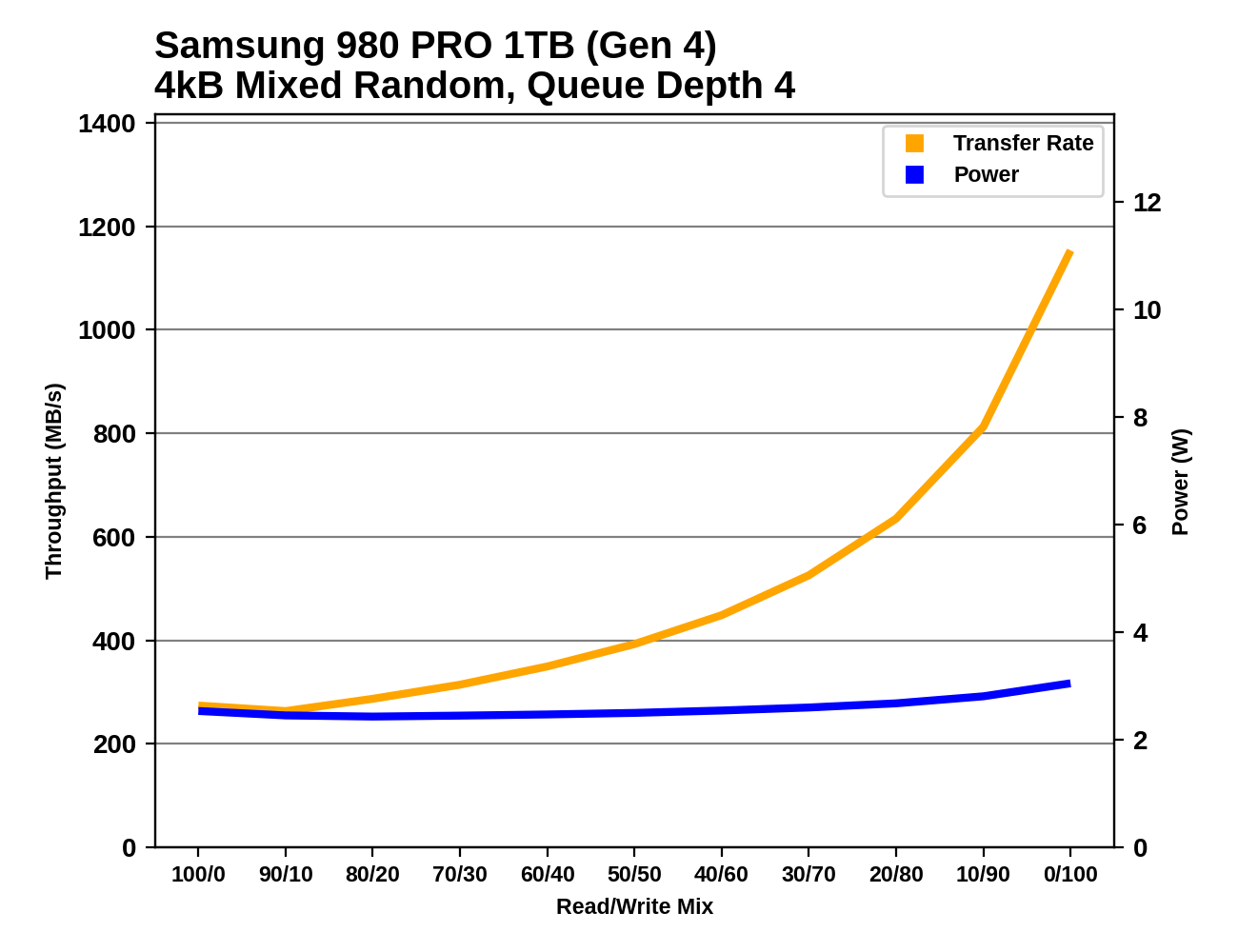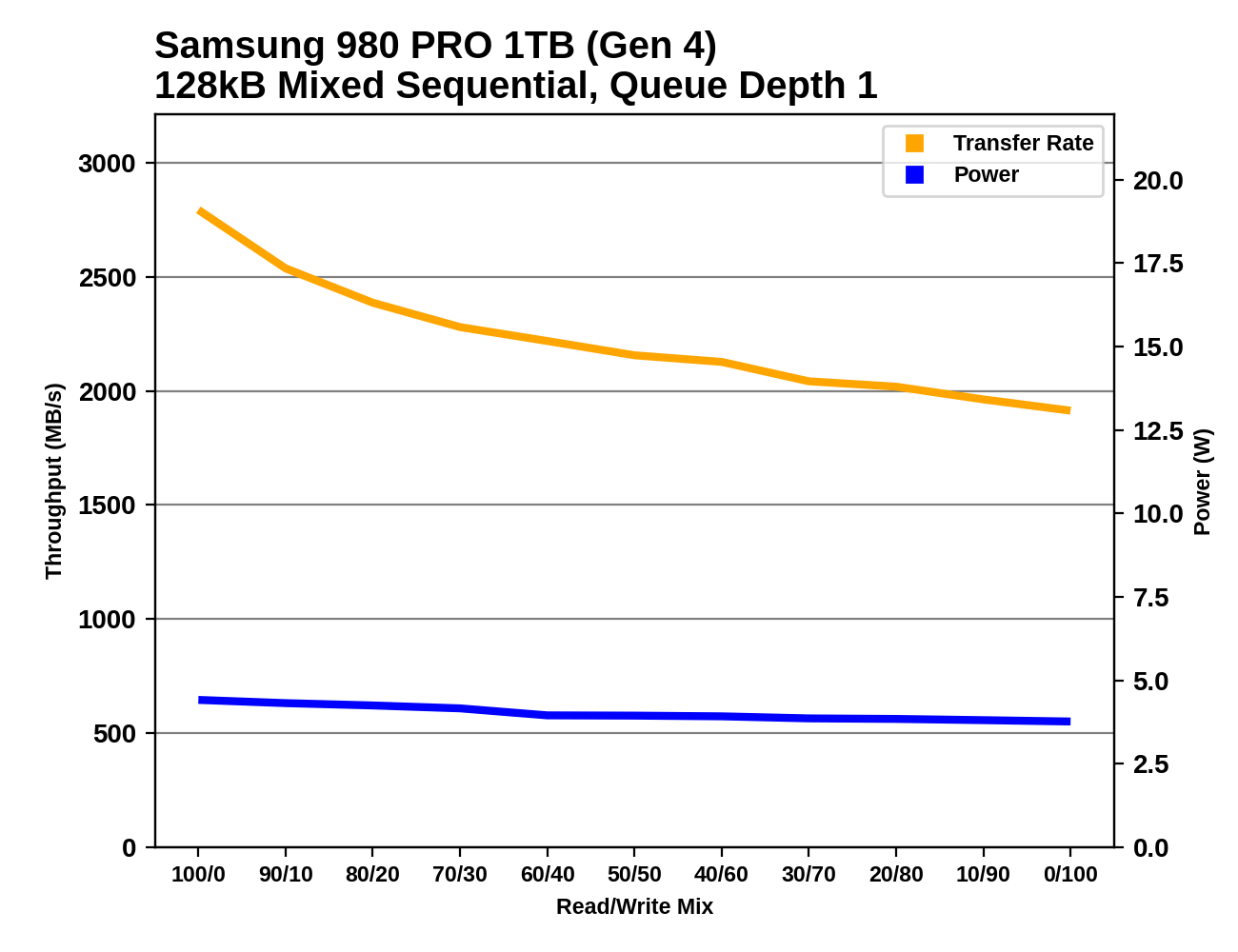The Samsung 980 PRO PCIe 4.0 SSD Review: A Spirit of Hope
by Billy Tallis on September 22, 2020 11:20 AM ESTNote: All our previous testing has been on an Intel test bed. Because of the move to PCIe 4.0, we have upgraded to Ryzen. Devices tested under Ryzen in time for this review are identified in the charts.
Mixed Random Performance
Our test of mixed random reads and writes covers mixes varying from pure reads to pure writes at 10% increments. Each mix is tested for up to 1 minute or 32GB of data transferred. The test is conducted with a queue depth of 4, and is limited to a 64GB span of the drive. In between each mix, the drive is given idle time of up to one minute so that the overall duty cycle is 50%.

Since our mixed random IO test uses a moderate queue depth of 4, the PCIe Gen4 drives don't get much chance to flex their muscle. The overall scores are still generally bound by NAND flash latency, which doesn't vary too widely between current generation drives. There's also a small performance boost when running this test on our newer, faster Ryzen testbed. The Samsung 980 PRO is clearly an improvement over its predecessors, but is merely tied for first place among flash-based drives with the SK hynix Gold P31.
 |
|||||||||
| Power Efficiency in MB/s/W | Average Power in W | ||||||||
Both capacities of the 980 PRO turn in good efficiency scores for the mixed random IO test, substantially improving on Samsung's previously mediocre standing. The 1TB 980 PRO's efficiency is second only to the SK hynix Gold P31. The 980 PROs are a bit more efficient running at PCIe Gen3 speeds than on the Gen4 platform, despite the ~10% performance boost on the faster system.
 |
|||||||||
There are no real surprises in the performance profiles of the 980 PROs. Both capacities show the same general behavior as earlier Samsung drives, albeit with small improvements to performance and power consumption across the board.
Mixed Sequential Performance
Our test of mixed sequential reads and writes differs from the mixed random I/O test by performing 128kB sequential accesses rather than 4kB accesses at random locations, and the sequential test is conducted at queue depth 1. The range of mixes tested is the same, and the timing and limits on data transfers are also the same as above.

The Samsung 980 PROs take the top spots for our mixed sequential IO test, with even the 250GB 980 PRO edging out the 1TB Seagate FireCuda 520. Even when limited to PCIe Gen3, the 980s are a clear step up in performance from eariler high-end drives. The improvement for the 250GB model is the most impressive, since the 250GB 970 EVO Plus is significantly slower than most of the 1TB drives.
 |
|||||||||
| Power Efficiency in MB/s/W | Average Power in W | ||||||||
The 980 PROs turn in more good power efficiency numbers that place them clearly ahead of everything other than the SK hynix Gold P31. And this time, the P31's efficiency lead relatively small at no more than about 25%.
 |
|||||||||
The 980 PROs show a drastically different performance profile compared to earlier Samsung drives. The 970s tend to bottom out during the write-heavy half of the test and recover some performance toward the end. Now with the 980 PRO, performance in the write-heavy half doesn't drop precipitously, so we see a steady decline that most closely resembles how the Intel Optane SSD handles this test










137 Comments
View All Comments
romrunning - Tuesday, September 22, 2020 - link
Agreed!Tomatotech - Wednesday, September 23, 2020 - link
See the StoragePro review for some eyebrow-raising numbers that may change your view.https://www.storagereview.com/review/samsung-980-p...
Tams80 - Tuesday, September 22, 2020 - link
What's the point of these if they are going to use TLC? They already make TLC SSDs and the market is pretty full.So what if using MLC is more expensive? Isn't the whole point of these to be their best of the best? And if an SLC cache benefits TLC SSDs, then why not have an MLC SSD with an SLC cache?
Kaziglu Bey - Tuesday, September 22, 2020 - link
Not the hope we're looking for.Time for me to buy another 2TB SX8200 Pro.
vladx - Thursday, September 24, 2020 - link
Yep, beyond enterprise workloads there's no point buying anything other than the SSD with best price/GB.Makaveli - Tuesday, September 22, 2020 - link
What were they thinking here.600 TBW on this "Pro" drive then a small 114GB SLC cache?
The E16 offers 1,800 TBW at 1TB and 333GB SLC cache.
Not impressed with this drive and looking forward to the E18 drives that are slowly coming out.
Luckz - Thursday, September 24, 2020 - link
You mean it will just use the entire empty SSD, because leaving the SSD empty is both a 'feature' and a smart use case? I barely even have 10% free on actively used SSDs.Golgatha777 - Tuesday, September 22, 2020 - link
For $20 more, I'll take a slight performance hit, but gain 4X the endurance by buying a 512GB 970 Pro. There's been nothing worth upgrading to since the 950 Pro when it comes to real world usage anyway though.MDD1963 - Tuesday, September 22, 2020 - link
I've written 30 TB in 3 years to my 960 EVO...; folks worried about 'only' 600 TBW (60 years at my rate usage?) specs are amusing.Makaveli - Tuesday, September 22, 2020 - link
And its assuming to me that you think your anecdotal point speaks for the whole market.